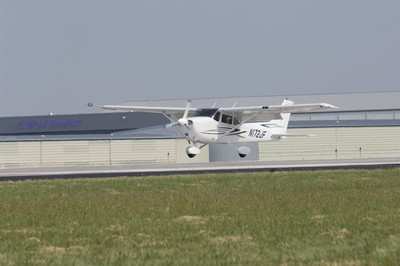Latest Installment In The Agency's Series On LOC Accidents
You may think of stabilized approaches in terms of instrument flying in large airplanes, but they’re equally important to pilots who fly smaller GA airplanes using visual flight rules (VFR).

As part of its #FlySafe series, the FAA says GA pilots should consider the following to maintain a stable approach:
- Maintain a constant speed and a constant descent rate that will safely put you in the best position to land with the least amount of work to do when you get there.
- Memorize your speeds and configuration data so you won’t have to check the Pilot’s Operating Handbook in the midst of a busy landing.
- If you’re not stable at 500 feet, or 1,000 feet when flying using instrument flight rules (IFR) — go around. Go-arounds are your best defense against landing accidents.
What is a De-Stabilized Approach? Excessive speed, excessive altitude, and the necessity for maneuvering can all contribute to a de-stabilized approach.
A stabilized approach is unlikely if you enter the pattern 150 knots or just above stall speed, or 1,000 feet above the pattern altitude. But, what if traffic congestion is forcing you to move faster or higher than your comfort zone?
If following traffic or complying with air traffic control (ATC) instructions will destabilize your flight, it’s time to exercise your pilot-in-command responsibility. Say the word “unable” and then establish a new plan.
For mission-oriented pilots, it’s hard to say “unable.” But, there’s no shame in missing an approach or going around and living to make another flight. If you can’t make the approach, just say so.
If you’re at or below 500 feet in VFR conditions and the approach isn’t stable, it’s time to go around.
If the runway is out of service, or there’s traffic on it, it’s time to go around.
Whatever the situation, the earlier you make the decision to go around, the easier it will be.
Once you’ve decided to go around, stick to that decision. Changing your mind after you’ve started the maneuver is bound to be de-stabilizing, and you’re too close to the ground for that.
When executing a missed approach or going around, you’re already close to the ground, so your first priority is to maintain aircraft control:
Arrest your descent, apply power to maintain altitude or climb as appropriate, and configure the airplane for climb or level flight.
With the aircraft under control, it’s time to navigate. For VFR, continue to the runway threshold while climbing to pattern altitude, then maneuver to remain in or reenter the pattern and follow ATC instructions as appropriate. For instrument flight rules (IFR), continue to the missed approach point and then either fly the missed approach procedure or follow ATC instructions.
Communicate your intentions, either through a call to ATC, or a call on the common traffic advisory frequency.
Be sure to plan for a go-around on every approach. Know when you’ll make the decision and execute the go-around at that point. And don’t second guess yourself. This is the time to stand by your decision.
An important part of maintaining a stabilized approach on landing is learning to manage distractions — especially while maneuvering close to the ground. Consider these tips to help keep you distraction-free:
Maintain a sterile cockpit while in departure, approach, and landing flight segments and while maneuvering.
Make sure your aircraft is stable before copying ATC instructions, changing charts, reviewing approach, and other tasks.
Keep your passenger busy by asking him or her to help you scan for traffic.
Finally, fly regularly with a flight instructor who will challenge you to review what you know, explore new horizons, and to always do your best.
Be sure to document your achievement in the Wings Proficiency Program. It’s a great way to stay on top of your game and keep your flight review current.
(Source: FAA. Image from file)
 ANN's Daily Aero-Linx (04.15.24)
ANN's Daily Aero-Linx (04.15.24) Classic Aero-TV: 'No Other Options' -- The Israeli Air Force's Danny Shapira
Classic Aero-TV: 'No Other Options' -- The Israeli Air Force's Danny Shapira Aero-News: Quote of the Day (04.15.24)
Aero-News: Quote of the Day (04.15.24) Airborne 04.16.24: RV Update, Affordable Flying Expo, Diamond Lil
Airborne 04.16.24: RV Update, Affordable Flying Expo, Diamond Lil ANN's Daily Aero-Term (04.16.24): Chart Supplement US
ANN's Daily Aero-Term (04.16.24): Chart Supplement US



